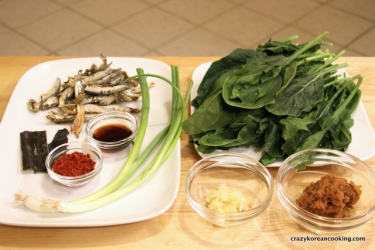Spinach Soybean Paste Soup, Shigeumchi Doenjang Guk
시금치 된장국

How about a delectable and healthy soup this evening? Spinach soybean paste soup (Si-geum-chi Doenjang-guk) has been a popular dish on the Korean dinner table for many years. It's very simple to make, and it's nutritious. Compared to doenjang jjigae (soybean paste stew), it's lighter in consistency and taste. It can pretty much complement anything.
There are many variations to this dish which feature other Korean greens, cabbages and mushrooms instead of spinach.
You can buy doenjang (soybean paste) online here.
How about a delectable and healthy soup this evening? Spinach soybean paste soup (Si-geum-chi Doenjang-guk) has been a popular dish on the Korean dinner table for many years. It's very simple to make, and it's nutritious. Compared to doenjang jjigae (soybean paste stew), it's lighter in consistency and taste. It can pretty much complement anything.
There are many variations to this dish which feature other Korean greens, cabbages and mushrooms instead of spinach.
You can buy doenjang (soybean paste) online here.
INGREDIENTS
shop these ingredients online »| 7 oz | Spinach 시금치 | |
| 6 cups | Water 물 | |
| 20 | Anchovy (dried) 멸치 | |
| 1 piece(s) | Kelp (dried, 2" X 2" or 5 cm x 5 cm) 다시마 (optional) | |
| 1 tbs | Garlic (minced) 다진 마늘 | |
| 2 | Green Onion 파 | |
| 2 tbs | Soybean paste (Doenjang) 된장 | |
| 1 tsp | Gochugaru, Korean Hot Pepper Flakes 고춧가루 (optional) | |
| 1 tsp | Soy Sauce for Soup (Gukganjang) 국간장 (optional, add salt instead) | |
| ¼ tsp | Salt 소금 |

Good to Know
Amount and types of doenjang
While doenjang is similar to Japanese miso, using Korean doenjang is highly recommended for an authentic Korean taste.
The color and saltiness of doenjang (soy bean paste) can vary depending on the brand. So, you may want to add more or less doenjang depending on the brand you use. It also depends on your personal preference. If you like a stronger doenjang flavor, you can add more doenjang and not use soy sauce for soup or salt.
Using a sifter when adding doenjang
In general, Koreans prefer not having soy bean bits in soup ("guk"), whereas they like them in stew ("jjigae"). Using a sifter allows only the subtle flavor and color of doenjang to accentuate the soup. However, you don't have to use a sifter if you prefer having soy bean bits in your soup.
What is the difference between Korean guk (soup) and Korean jjigae (stew)?
Korean stews are supposed to be a salty dish you eat little by little with rice. It's usually placed in the middle of the table and shared with a few people. Korean soups are more of an individual dish that is less salty and usually served in larger portions and in individual bowls.
For doenjang guk (soup), add doenjang until the broth is just slightly brown in color, then season with soy sauce (for soup) and salt. For doenjang jjigae (stew), only doenjang is used to season the soup because you want to have a thicker consistency and a stronger doenjang flavor.
Optional Ingredients and Substitutions
Kelp is optional.
Gochugaru, red chili flakes is optional.
Soy sauce for soup, gukganjang is optional. You can use salt for seasoning instead.
Anchovy broth is most ideal for classic spinach doenjang guk. There is a variation which is made with beef bone broth.
instructions |
photos |
summary |
|---|---|---|
Ingredient amounts in the recipe instructions are for the default serving size. |
Click to enlarge photos. |
Ingredient amounts in the recipe summary are for the default serving size. |
1. Make BrothBoil 6 cups of water. Add about 15-20 heads of anchovy in a anchovy mesh net and 1 piece of 2” X 2” (5cm x 5cm) kelp (kelp is optional) into boiling water. Let it boil with a lid on medium heat for 15 min. Remove anchovies and kelp from the broth. |
1
Boil 6 cups water Add
Boil Med Heat with lid | |
2. Prepare SpinachWhile making broth, prepare spinach. Cut off the root ends of the spinach with scissors. Wash it thoroughly under running water. |
2
Cut root ends Wash thoroughly | |
3. Blanch spinachBoil 4 cups of water on high heat. Add spinach in boiling water and leave on high heat until the leaves die down (for 30 seconds to 1 min). |
3
Boil 4 cups water High Heat Blanch in boiling water | |
4. RinseImmediately rinse spinach in cold water. Remove excess water by squeezing lightly with your hand. |
4
Rinse in cold water Squeeze water out | |
5. Prepare Green OnionCut off the root ends and wash them thoroughly. Cut them diagonally into 1½ inch pieces. |
5
Cut off root end Wash thoroughly Cut into 1½” diagonally | |
6. SeasonDissolve 1½ tablespoons of doenjang (soybean paste) into the broth by rubbing over a sifter. You may add a bit less or more doenjang depending on the brand. Aim for a light brown colored broth. Add 1 teaspoon of red chili flakes (optional) and 1 tablespoon of minced garlic. Let it boil for 4 min on medium heat with a lid. |
6
Dissolve with sifter
Boil Med Heat with lid | |
7. Add SpinachAdd the blanched spinach and cut green onions. Add 1 teaspoon of gukganjang (soy sauce for soup) - optional. Boil with a lid on medium heat for 10 min. Skim off foam if there is any. |
7
Add
Add 1 tsp gukganjang (optional) Boil Med Heat | |
8. FinishTaste it. Add salt only if needed. Serve with rice. Enjoy! |
8
Enjoy! |













 15 min
15 min